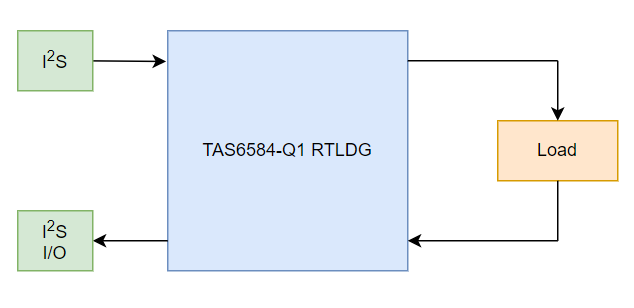SLOA321 February 2022 TAS6584-Q1
This application brief discusses the embedded implementation of real-time load diagnostics feature in the TAS6584-Q1 automotive 45-V, four-channel Class-D audio amplifier IC. While AC and DC diagnostics verifies the status of the load before enabling the output, real-time load diagnostics monitors the speaker output conditions while audio is playing and fault conditions are notified through the I2C bus and a designated I/O pin. The TAS6584-Q1 is able to detect in real-time an open load, short load, short-to-ground, and short-to-power condition by using integrated current sensing circuitry.
Real-Time Load Diagnostics in Class-D AmplifiersThe TAS6584-Q1 not only provides AC and DC diagnostics, which detect load fault conditions before audio is playing, but also provides embedded real-time load diagnostic capabilities. These capabilites allow the device to monitor the current of the load while the audio is playing to determine short load, open load, short-to-ground, and short-to-power faults. Real-time load diagnostics can be run simultaneously while audio is playing or can be enabled or disabled individually. Figure 1-1 shows a simplified block diagram of Real-Time load diagnostics (RTLDG) for the TAS6584-Q1.
 Figure 1-1 TAS6584-Q1 Real-Time Load
Diagnostics
Figure 1-1 TAS6584-Q1 Real-Time Load
DiagnosticsPrevious Automotive Class-D audio amplifiers detected short and open load conditions before the audio began to play, preventing audio from playing if a fault condition is detected. The TAS6584-Q1 not only includes these diagnostics but also uses the embedded current sense capabilities. The TAS6584-Q1 uses the sensed current to detect short load and open load faults while audio is playing. The TAS6584-Q1 internally generates an always present, inaudible audio signal in the DSP. This is called a Pilot Tone. The pilot tone is mixed into the audio signal. After filtering and demodulation, the output impedance is able to be continuously detected. This impedance is compared to thresholds the user configures to detect shorted load and open load circumstances. The user can configure the shorted load and open load thresholds individually before the real-time load diagnostics are enabled.
If the output impedance is higher than the open load threshold, then an open load is reported to the register. If the output impedance is lower than the shorted threshold, then a shorted load is reported to the register. When a shorted load or open load event is detected, the flags are reported to theRTLDG OL SL Fault Mem register. These events can then be directly routed to
one of the I/O pins on the device as either fault events or warning events. These signals are
also provided to the user through the I2C bus. Channels that encounter short load or open load
threshold violations stop switching and are moved into a FAULT state. The FAULT must be
cleared before the channel can be restarted and the real-time load diagnostics must be
reprogrammed.RTLDG Fault Mem
register. Similar to the SL and OL flag, this signal can also be routed directly to one of the
I/O pins on the device as a fault event. If a channel detects a short-to-power or
short-to-ground event, the channel stops switching and moves into a FAULT state. This FAULT
must be clear before the channel can be restarted and the real-time load diagnostics must be
re-enabled.PurePath™ Console
Texas Instruments offers a powerful audio design tool called PurePath Console, which provides a simple and easy-to-use GUI to assist with audio evaluation and design. An interface with real-time results of the real-time load diagnostic tests used in the PurePath Console demonstrates the real-time current sense capabilities of the TAS6584-Q1.
To access more information about real-time load diagnostics or more information about the TAS6584-Q1, please contact Texas Instruments.
Resources
- Texas Instruments, TAS6584-Q1-Automotive 45-V, 10-A digital input, four-channel Class-D audio amplifier with current sense product page
- Texas Instruments, TAS6584-Q1 EVM tools page
- Texas Instruments, Diagnostics and Protections in Automotive Audio Systems application brief
- Texas Instruments, PurePath™ Console graphical development suite for audio system design and development